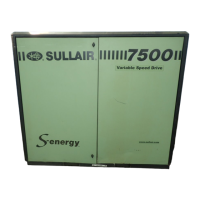4500P-7500 USER MANUAL SECTION 6
62
WATER CONDENSATE DRAIN MAINTENANCE
If the compressor is fitted with the standard solenoid
condensate drain valve, it is necessary to periodically
clean the strainer. Remove the knurled cap from the
strainer and remove the strainer screen. Clean the
screen and reinstall. If the screen is damaged, the
strainer assembly must be replaced (02250171-245).
CONTROL LINE STRAINER
The regulator and solenoid valve(s), which control
the compressor, are protected by a strainer. Clean
the strainer every 12 months. Remove the hex cap
from the strainer and remove the strainer screen.
Clean the screen and reinstall. If the screen is
damaged, the strainer assembly must be replaced
(241772).
SHAFT COUPLING MAINTENANCE
The compressor unit and motor are rigidly connected
through the mounting adapter housing. This
arrangement makes coupling alignment
unnecessary. The coupling is a jaw type in shear. If
the elastomeric (rubber) element requires
replacement due to wear or damage, order a
replacement element and perform the following
steps:
1. Remove the protective grill from the adapter
housing.
2. Loosen the retaining screw located on the
outer sleeve. Slide the sleeve to one side,
exposing the coupling element.
3. Unwrap the coupling element from the
coupling jaws.
4. Install the new element by wrapping it
around the jaws, engaging the cogs on the
element into the jaws.
5. Reinstall the outer sleeve and secure by
tightening the two screws to 45 in·lbs (5 Nm).
6. Reinstall the protective grill.
HOSE MAINTENANCE
Lubrication and blowdown hose replacement is
recommended after three (3) years or 16,000 hours
of operation. Order hose kit 02250171-102 for air-
cooled, or 02250171-103 for water-cooled machines.
6.8 TROUBLESHOOTING –
INTRODUCTION
The information in the Troubleshooting Guide
describe symptoms and usual causes for the listed
discrepancies. However, DO NOT assume that these
are the only malfunctions or fault conditions that may
occur.
NOTE
For additional troubleshooting guidelines,
consult the WS Controller manual.
TABLE 6-1: TROUBLE SHOOTING GUIDE
SYMPTOM PROBABLE CAUSE REMEDY
Compressor will not start Main disconnect switch open close switch.
Line fuse blown Replace fuse.
Motor starter overload tripped Reset - if fault persists, check motor
contacts for proper function.
Low incoming line voltage Check voltage - in the case of low voltage,
check power source, or contact local power
company.
Compressor shuts down
under service load conditions
Loss of control voltage Check 24V DC power supply for correct
output - replace power supply if necessary.
Low incoming line voltage Check voltage - in the case of low voltage,
check power source, or contact local power
company.
High operating pressure Reset - if fault persists, check line pressure
and ensure that it does not exceed the
compressor’s maximum operating pressure
(specified on nameplate - See Figure 7-1).

